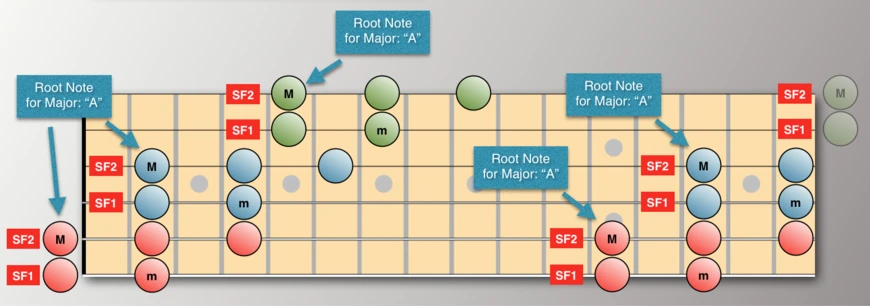
In this post we explore a simple system that enables you to map diagonal pentatonic fingerings that run through the whole length of the fretboard.
A Pentatonic is a five-note scale. The fact that it has only five notes creates a very interesting fingering possibility: By using just 2 string fragments with 3 notes on one of them and 2 on the other, you can cover the whole scale on just two strings.
You can then repeat the same 2-string pattern on the next pair of strings, and then the next, creating a very easy to learn 3-octave diagonal fingering.
However, there is one problem with all this: Putting 3 notes of a pentatonic scale on just one string requires in most cases a very big stretch. Combine that with the need for a big horizontal shift for each string pair and you get fingerings that are not very practical. Here is an example:

This is why most players avoid almost all 3+2/2+3 Pentatonics.
Thankfully, there is an exception to this. There is one configuration that is actually very playable:

The way to map this on the fretboard is either by using the 2nd note of SF1 as the Root Note to get a Minor Pentatonic (“m” on the diagram), or use the 1st note of SF2 as the Root Note to get a Major Pentatonic ("M").
It doesn’t matter on which string you do this. However you start, you always end up with one of just two possible diagonal fingerings. Here they are for A minor / C major:


You can think of this as a “mini SFS” (SFS = String Fragment System). Don’t forget to shift up one fret when crossing from string 3 to string 2 as we always do with SFS.
Note that you can avoid the stretch altogether and just slide your 3rd finger when ascending, or your 1st when descending.
That’s it. With very little memorization we came up with a quick and effective way to travel the whole fretboard.
Have fun with this and remember: Enjoy your practice and be effective!
Using any pentatonic fingering for both Minor and Major is all about where you place the Root Note.
If you position the system so that "m" is on the note "A" then you get a minor pentatonic. If you do it so that "M" is on the note "A", then you get a major pentatonic.
It's the same concept with what we start doing in SFS pentatonics lesson 2 and later. The same SFS can be used for both minor and major, as long as you place it correctly with respect to the Root Notes for minor and major.
For this example, here are the resulting shapes for A major:

